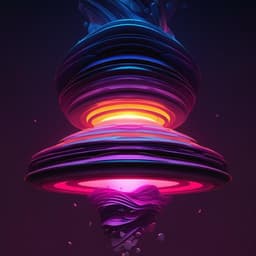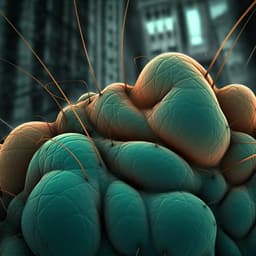
Physics
Efficient experimental quantum fingerprinting with channel multiplexing and simultaneous detection
X. Zhong, F. Xu, et al.
Discover a groundbreaking quantum fingerprinting protocol developed by Xiaoqing Zhong, Feihu Xu, Hoi-Kwong Lo, and Li Qian, utilizing coherent states and channel multiplexing. This innovative approach not only speeds up communication significantly but also outperforms classical limits without the need for costly detection technology. A proof-of-concept with six wavelength channels showcases exceptional performance, setting new standards in the field!
~3 min • Beginner • English
Introduction
The paper addresses how to reduce both communication time and the amount of communicated information in quantum fingerprinting while using practical devices. Classical simultaneous-message fingerprinting requires O(n) bits, whereas quantum fingerprinting can, in principle, achieve O(log n) qubits, but existing coherent-state quantum fingerprinting (CQF) implementations still require many optical modes, leading to long communication times and sensitivity to detector dark counts. The authors propose using wavelength-division multiplexing (WDM) with simultaneous detection (WDM-CQF) to increase channel capacity, shorten communication time by a factor k (number of wavelength channels), and lower the total mean photon number required for a target error rate, thereby reducing the communicated information. The work is motivated by the desire to surpass classical limits without expensive SNSPDs and to demonstrate practical quantum advantage with standard single-photon avalanche diodes.
Literature Review
Prior work established exponential advantages of quantum communication complexity and the concept of quantum fingerprinting in the simultaneous-message model, with theoretical O(log n) scaling using qubits. Early experimental demonstrations verified small-instance advantages with single-qubit protocols, but scalable exponential advantage requires complex entangled states. A practical coherent-state-based quantum fingerprinting (CQF) protocol was proposed that uses phase-encoded weak coherent pulses with total mean photon number μ and achieves O(log n) communication; proof-of-principle experiments showed reduced communicated information relative to the best-known classical protocol but suffered from communication time scaling with the number of modes and sensitivity to dark counts. Use of SNSPDs greatly improved CQF performance and could beat the classical limit, but at high cost. WDM is well-established in classical communications for boosting capacity and has been explored in some quantum communication contexts (e.g., multiuser QKD, Euclidean distance estimation with coherent fingerprints) typically requiring demultiplexing and multiple detectors. The present work extends WDM to coherent quantum fingerprinting without demultiplexing, enabling simultaneous multiwavelength interference on a shared detector pair to lower μ and improve performance.
Methodology
Theory and protocol: In the CQF protocol, Alice and Bob encode their n-bit inputs x and y using an error-correcting code (ECC) of rate c and minimum relative Hamming distance δ to obtain m = n/c codeword bits E(x), E(y). They prepare phase-encoded coherent-state fingerprints composed of m pulses with total mean photon number μ. The amount of communicated information scales as Q = O(log2 m) = O(log2 n). In the proposed WDM-CQF, each fingerprint is partitioned into k subfingerprints and mapped to k wavelength channels; each subfingerprint has m/k pulses. The k channels are multiplexed and transmitted; at the referee (Charlie), the wavelength-composite pulses from Alice and Bob interfere on a balanced beam splitter and are detected by a single pair of SPDs without demultiplexing, enabling independent but simultaneous interference per wavelength per time slot. This reduces the communication time by a factor k and, crucially, increases the effective signal-click probability per detection window without increasing μ, allowing a smaller μ to meet a target error probability.
Decision mechanism and error model: For each detection window, the probability of a click at D1 for equal inputs (P_E) and different inputs (P_D) are modeled including interference visibility υ, channel/detector transmittance η (including detector efficiency), and detector dark-count probability P_dark. With M = m/k total wavelength-composite pulses sent to Charlie, the D1 counts follow binomial distributions B(M, P_E) and B(M, P_D), well-approximated by Poisson distributions for large m and small probabilities. Charlie selects a threshold C_th; if total D1 counts < C_th, declare equal; otherwise different. The error probability is P_error = max{Pr(C1,E > C_th), Pr(C1,D < C_th)}; Chernoff bounds provide analytical upper bounds and facilitate choosing μ to satisfy P_error ≤ ε. Simultaneous detection increases P_E,signal and P_D,signal while keeping μ low; for practical μ and k up to ~1000, the probability that more than one wavelength component contains photons in a detection window is negligible relative to P_dark, justifying no demultiplexing.
Experimental setup: A two-way Sagnac interferometer provides a stable phase reference and common-path interference. Six CW lasers (λ = 1542.9–1554.9 nm, 2.4 nm spacing) at Charlie are multiplexed, polarization-aligned, intensity-modulated into 500 ps weak coherent pulses at 50 MHz, and attenuated. Pulses enter the Sagnac loop via a 50:50 fiber BS and traverse 20 km SMF in both clockwise and counterclockwise directions (to Alice and Bob). Chromatic dispersion and 6.9 km dispersion-compensation fiber (DCF) are used to temporally separate wavelengths at the users for sequential phase modulation (about 820 ps separation, 800 ps modulation windows), then recombine to overlap at Charlie (δt_C ≈ 0 ps). Polarization alignment across wavelengths employs principal states of polarization using multiple polarization controllers to maintain ~97% visibility over 12 nm bandwidth. Detection uses two InGaAs SPADs (ID220, 20% efficiency, 1000 Hz dark counts, 500 ps gates). Charlie records total D1 counts and compares with a preset threshold. Inputs sizes tested range from 1.44×10^6 to 1.08×10^9; ECC with c = 0.2398 and δ = 0.22 is used. Simulations complement experiments, using SPAD parameters (25% efficiency, 100 Hz dark counts) and varying k to assess scaling over 0, 40, and 80 km total distance.
Key Findings
- Theory and simulation: WDM-CQF reduces the required total mean photon number μ for a target error rate by enabling simultaneous detection from k wavelength channels without demultiplexing, thus decreasing communicated information Q while also reducing communication time by ~1/k. Simulations with practical SPAD parameters (25% efficiency, 100 Hz dark counts, 500 ps gates, 97% visibility, ECC c = 0.2398, δ = 0.22) show: (i) WDM-CQF with k ≥ 10 beats the classical limit at 0 km; (ii) at 40 km, about k ≈ 100 channels suffice to beat the classical limit without SNSPDs; (iii) for k ≥ 100, the amount of communication is reduced by at least an order of magnitude compared to single-wavelength CQF (k = 1). Increasing k compensates for channel loss without resorting to ultralow-dark-count detectors.
- Experimental demonstration: Implemented k = 6 WDM-CQF over a Sagnac loop with ~40 km total SMF plus 6.9 km DCF. Achieved ~97% interference visibility. Detection with ID220 SPADs (20% efficiency, 1000 Hz dark counts). Tested seven input sizes n from 1.44×10^6 to 1.08×10^9, for equal and 1-bit different cases. Thresholding on total D1 counts successfully discriminated cases; measured decision error probabilities ranged up to 2.7×10^-5 and were within tolerable levels. The communicated information Q (equivalent qubits) ranged from ~3.7×10^4 to ~4.24×10^5 across tested n. For all n, the experimental WDM-CQF communicated less than the best-known classical protocol and also less than the original CQF under the same parameters; for large n, the reduction versus single-wavelength CQF exceeded a factor of two. Compared to a prior single-wavelength CQF experiment using the same detectors over ~5 km, the present 40 km WDM experiment achieved substantially lower communicated information, underscoring robustness to losses and dark counts.
- Practical impact: The protocol can beat the classical limit without SNSPDs by leveraging multiplexing and simultaneous detection; the hardware cost scales mainly with adding wavelength channels and not low-temperature detectors.
Discussion
The study demonstrates that simultaneous multiwavelength interference and shared detection in coherent-state quantum fingerprinting directly address two core challenges of prior CQF implementations: excessive communication time (due to many time modes) and sensitivity to detector dark counts (which set a floor on μ and hence on Q). By increasing k, WDM-CQF shortens communication time and increases per-window signal detection probability, allowing smaller μ while maintaining a target error rate. Simulations indicate that even with standard SPADs, WDM-CQF can beat the classical limit over realistic distances (0–80 km) for moderate k, and experiments with k = 6 confirm a substantial reduction in communication versus both the classical baseline and the original CQF. The approach is scalable by combining WDM with other multiplexing (e.g., time-division multiplexing) and suggests significant energy savings since far fewer photons are sent per bit compared to classical schemes. The method is broadly applicable to other quantum communication tasks that rely on interference-based comparisons (e.g., swap tests, quantum digital signatures).
Conclusion
The authors introduce WDM-CQF, a coherent-state quantum fingerprinting protocol that employs wavelength-division multiplexing and simultaneous detection without demultiplexing. This design reduces both the amount of communicated information and the communication time relative to original CQF, and can surpass the classical limit using standard SPADs. A proof-of-concept k = 6 experiment over ~40 km validates these advantages and shows more than twofold reduction in communicated information compared to single-wavelength CQF for large inputs. Simulations suggest that with k around 100, the protocol beats the classical limit at 40 km without SNSPDs, and increasing k can offset channel loss. Future work includes enabling true simultaneous per-wavelength phase modulation (e.g., via spatial dispersion) to realize full time reduction in practice; scaling to larger k using combinations of WDM and TDM; managing polarization over broader bandwidths; studying cross-talk in ultra-dense WDM; removing the two-way phase-reference requirement (e.g., higher-order interference methods) while exploring multiplexing in such schemes; and extending simultaneous-detection multiplexing to other quantum communication protocols.
Limitations
- Experimental time reduction was not strictly realized because per-wavelength phase modulation was done sequentially using temporal dispersion; simultaneous modulation would be needed to fully shorten communication time.
- The number of wavelength channels was limited by the sequential modulation scheme and repetition rate (≈12 channels with 2.4 nm spacing and 10 ns period); broader scaling requires different modulation (spatial dispersion) or parameter changes.
- Polarization-mode dispersion across multiple wavelengths complicates alignment; the principal state of polarization method worked over 12 nm but may degrade for larger bandwidths, requiring additional polarization control or polarizers with careful per-channel power balancing.
- Cross-talk between adjacent channels was neglected given low per-channel intensity and moderate spacing; ultra-dense WDM may necessitate cross-talk analysis.
- Validity of ignoring multiwavelength photon contributions relies on small μ and large M; for small M (<10^6), the assumption may break and performance could degrade.
- The Poisson approximation and Chernoff-bound-based μ optimization provide upper bounds that may be loose; exact optimization can be computationally heavier for very large M.
- The experimental platform used a two-way Sagnac (Alice and Bob physically connected) to maintain a phase reference; independent-source implementations would require alternative phase-reference-free methods.
Related Publications
Explore these studies to deepen your understanding of the subject.







